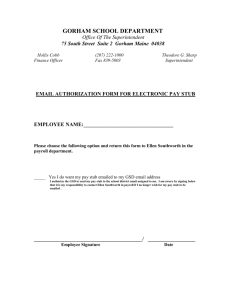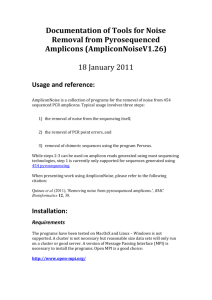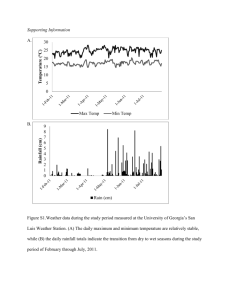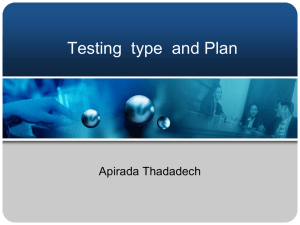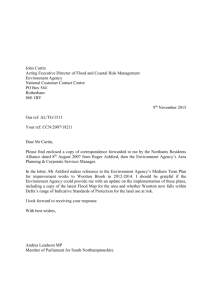echo "Running SeqDist"
advertisement
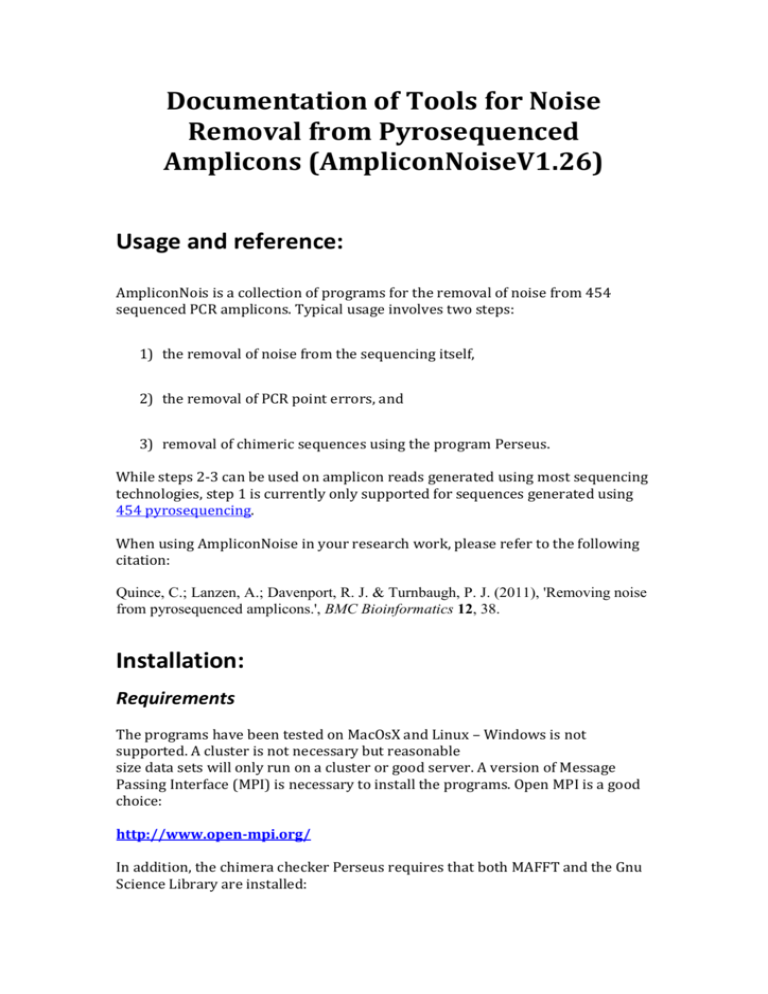
Documentation of Tools for Noise
Removal from Pyrosequenced
Amplicons (AmpliconNoiseV1.26)
Usage and reference:
AmpliconNois is a collection of programs for the removal of noise from 454
sequenced PCR amplicons. Typical usage involves two steps:
1) the removal of noise from the sequencing itself,
2) the removal of PCR point errors, and
3) removal of chimeric sequences using the program Perseus.
While steps 2-3 can be used on amplicon reads generated using most sequencing
technologies, step 1 is currently only supported for sequences generated using
454 pyrosequencing.
When using AmpliconNoise in your research work, please refer to the following
citation:
Quince, C.; Lanzen, A.; Davenport, R. J. & Turnbaugh, P. J. (2011), 'Removing noise
from pyrosequenced amplicons.', BMC Bioinformatics 12, 38.
Installation:
Requirements
The programs have been tested on MacOsX and Linux – Windows is not
supported. A cluster is not necessary but reasonable
size data sets will only run on a cluster or good server. A version of Message
Passing Interface (MPI) is necessary to install the programs. Open MPI is a good
choice:
http://www.open-mpi.org/
In addition, the chimera checker Perseus requires that both MAFFT and the Gnu
Science Library are installed:
http://mafft.cbrc.jp/alignment/software/
http://www.gnu.org/software/gsl/
Installation procedure
First unzip the programs:
unzip AmpliconNoiseV1.26.zip
To compile the programs, move into the top directory and type:
make clean
make
Any errors here may require changing the default C- (cc) and C-MPI
compilers (mpicc) in the individual makefiles associated with the
executables.
If the programs compile without errors, type:
make install
This will place the executables in the bin directory. This directory and the
Scripts directory need to be added to your $PATH in order to run the
programs from the command line. If you unzip AmpliconNoiseV1.23.zip in
your home directory ($HOME) then this command should be added to your
.bashrc or .profile or equivalent. Edit this file and add these two line:
export PATH=$HOME/AmpliconNoiseV1.26/bin:$PATH
export PATH=$HOME/AmpliconNoiseV1.26/Scripts:$PATH
You should also set environment variables to specify the location of lookup tables used by the programs. These define the noise distributions. The
following commands ensure that the file LookUp_Titanium.dat* is always
used for PyroDist and PyroNoise and Tran.dat by SeqDist and SeqNoise.
Having set these the programs can be run anywhere otherwise they can
only be run from inside the bin directory. Add the two following lines to
your .bashrc or .profile located in your home directory:
export AMPLICON_NOISE_HOME=$HOME/AmpliconNoiseV1.26/
export
PYRO_LOOKUP_FILE=$HOME/AmpliconNoiseV1.26/Data/LookUp_Tit
anium.dat
export
SEQ_LOOKUP_FILE=$HOME/AmpliconNoiseV1.26/Data/Tran.dat
Then either open a new terminal window or source the file to activate
these environment variables:
source ~/.bashrc
*If working with sequencing data generated using an older Pyrosequencing
protocol or machine such as (non-Titanium) GS FLX or GS 20, then the file
LookUp_E123.dat located in the same directory should be used instead of
LookUp_Titanium.dat
Testing the installation by running an example
analysis
The directory Test contains the shell script Run.sh which will run through
the entire de-noising process for a single dat file. A smallish file consisting
of 2094 GS FLX reads, which will process on a good MacBook in ten or
twenty minutes C005.dat is included. This should be run as follows:
./Run.sh C005.dat
If this works correctly the de-noised file C005_s60_c01_T220_s30_c08_cd.fa
with just 18 sequences will be generated. The file
C005_s60_c01_T220_s30_c08_cd.mapping will map these back to the original
reads. Other files reflecting the intermediate steps are also generated but
in general they can be ignored. The list file giving complete linkage OTUs
for these sequences is also produced C005_s60_c01_T220_s30_c08.list.
Running AmpliconNoise on medium-size datasets
In the directory Scripts in the AmpliconNoise installation directory, there
are a number of scripts for running the typical analysis workflow.
The scripts RunTitanium.sh and RunPreSplit.sh are found in the directory
Scripts. These can be executed directly on the raw output from
pyrosequencing, which is supplied as flowgram or “SFF-file” with the suffix
“.sff”. These scripts will run in a reasonable time for datasets of with to
about 20,000 reads sharing the same (or no) barcode, but this also depends
on the evenness of the dataset and the memory available. For larger
datasets, see the section “Running Larger Datasets” below.
RunTitanium.sh and RunFLX.sh
These script are used when if several barcoded sequence datasets were
provided by the sequencing facility in the same flowgram (SFF) file. It is
also used for medium-sized datasets not using barcoded primers.
RunTitanium.sh is used for GS FLX Titanium or GS FLX Titanium+ datasets
whereas RunFLX.sh is used for GS FLX or GS20 datasets.
In addition to the flowgram file, a comma-separated text-file named
keys.csv needs to be present in the same directory. This file should contain
one line for each barcode containing the sample name, comma and the
barcode sequence, excluding the primer sequence used, e.g.:
Sample07,CTCGCGTGTC
If no such file is supplied, it is assumed that the sequence data contains no
barcodes. In addition to keys.csv, a file containing the primer sequence
named primer.fasta has to be supplied, e.g.:
>787F
ATTAGATACCCNGGTAG
Note that this file may contain degenerated base characters, such as ‘N’.
As a default, the script is run using 4 parallel processes. To change this
value, edit the script or make a local copy of the it and edit that. Change line
“nodes=4” to as many processes as you would like to run. Larger datasets
can be processed with this script on a cluster by increasing this value to e.g.
16 or 32.
The script is then executed simply by supplying the name of the flowgram
file, e.g.
RunTitanium.sh MySamples.sff
RunPreSplit.sh
This script is used for barcoded sequence datasets that have already been
split up by the sequencing facility, so that one flowgram (SFF) file contains
one sample. It is used like the RunTitanium.sh script described above,
except that no keys.csv file is needed. For
Output of AmpliconNoise
…
--
The different steps in the AmpliconNoise workflow
SFF parsing..
..
....any dat file with ids can be used
echo "Calculating .fdist file"
mpirun -np $nodes PyroDist -in $file -out ${stub} >
${stub}.fout
..this starts the analysis by calculating flowgram distances using PyroDist
echo "Clustering .fdist file"
FCluster -in ${stub}.fdist -out ${stub}_X > ${stub}.fout
..then hierarchical clustering with complete linkage is carried out using
FCluster to provide input file for PyroNoise
rm ${stub}.fdist
rm ${stub}_X.otu ${stub}_X.tree
(..removes some intermediate files)
echo "Running PyroNoise"
mpirun -np $nodes PyroNoiseM -din ${file} -out
${stub}_s60_c01 -lin ${stub}_X.list -s 60.0 -c 0.01 >
${stub}_s60_c01.pout
..this performs the flowgram clustering according to the EM algorithm
implemented in PyroNoise to remove pyrosequencing noise
Truncate.pl 220 < ${stub}_s60_c01_cd.fa >
${stub}_s60_c01_T220.fa
..the end of reads are often noisy so we truncate to 220 base pairs. If
degenerate primers are used they should perhaps be removed at this point
although that this optional.
echo "Running SeqDist"
mpirun -np $nodes SeqDist -in ${stub}_s60_c01_T220.fa >
${stub}_s60_c01_T220.seqdist
..Now we calculate the PCR error corrected distances between sequences
using SeqDist
FCluster -in ${stub}_s60_c01_T220.seqdist -out
${stub}_s60_c01_T220_S > ${stub}_s60_c01_T220.fcout
..Complete linkage clustering (again using FCluster) is carried out to
provide input to SeqNoise
echo "Running SeqNoise"
mpirun -np $nodes SeqNoise –in ${stub}_s60_c01_T220.fa din ${stub}_s60_c01_T220.seqdist -lin
${stub}_s60_c01_T220_S.list -out
${stub}_s60_c01_T220_s30_c08 -s 30.0 -c 0.08 -min
${stub}_s60_c01.mapping > ${stub}_s60_c01_T220.snout
rm ${stub}_s60_c01_T220_S.otu ${stub}_s60_c01_T220_S.tree
${stub}_s60_c01_T220.seqdist
…SeqNoise implements the sequence clustering algorithm that removes
PCR errors
echo "Clustering OTUs"
mpirun -np $nodes NDist -i -in
${stub}_s60_c01_T220_s30_c08_cd.fa >
${stub}_s60_c01_T220_s30_c08.ndist
FCluster -i -in ${stub}_s60_c01_T220_s30_c08.ndist -out
${stub}_s60_c01_T220_s30_c08 >
${stub}_s60_c01_T220_s30_c08.fcout
..Finally we build OTUs from the de-noised sequences
Running larger datasets
The directory TestFull contains a shell script that illustrates the de-noising
process for a larger sample that needs to be split to allow de-noising. This
should only be run on a cluster or good server. It is assumed that a single
sample without barcodes is used. The script takes an .sff file as an
argument but in case sffinfo (a 454 program) is absent we have provided
ArtificialGSFLX.sff.txt an sff that has already been converted into text.
The script should be run in general as:
./Run.sh My.sff primer
and for test purposes:
./Run.sh ArtificialGSFLX.sff
#!/bin/bash
defaultPrimer="ATTAGATACCC\w{1}GGTAG" #default primer
nodes=8
#no. of cluster nodes to use
sfffile=$1; #first argument name of sff file (necessary)
primer=${2:-$defaultPrimer} #second argument primer as a Perl regular
expression
(the second argument should be your primer else it defaults to our 787f)
stub=${sfffile%.sff};
echo $stub $sfffile $primer
# first generate sff text file if necessary
if [ ! -f ${sfffile}.txt ]; then
echo "Generating .sff.txt file"
sffinfo $sfffile > ${sfffile}.txt
fi
(generates text translation of sff file if necessary)
#generate flowgram and fasta files
if [ ! -f ${stub}.dat ]; then
echo "Generating .dat file"
FlowsFA360.pl $primer $stub < ${sfffile}.txt
fi
(extracts filtered dat and sequence files)
#get unique sequences
if [ ! -f ${stub}_U.fa ]; then
echo "Getting unique sequences"
FastaUnique -in ${stub}.fa > ${stub}_U.fa
fi
(generates a file of unique sequences)
#use NDist to get sequence distances
if [ ! -f ${stub}_U_I.list ]; then
echo "Calculating sequence distances"
mpirun -np $nodes NDist -i -in ${stub}_U.fa > ${stub}_U_I.ndist
fi
#use NDist to get sequence distances
if [ ! -f ${stub}_U_I.list ]; then
echo "Cluster sequences..";
#cluster sequences using average linkage and sequence weights
FCluster -a -w -in ${stub}_U_I.ndist -out ${stub}_U_I > ${stub}_U_I.fcout
fi
rm ${stub}_U_I.ndist
(These two steps use the unique sequences to generate an average linkage
tree based on sequence distance…)
SplitClusterEven -din ${stub}.dat -min ${stub}.map -tin ${stub}_U_I.tree -s
5000 -m 1000 > ${stub}_split.stats
(that is then used to split up the .dat file)
echo "Calculating .fdist files"
for c in C*
do
if [ -d $c ] ; then
mpirun -np $nodes PyroDist -in ${c}/${c}.dat -out ${c}/${c} >
${c}/${c}.fout
fi
done
(Now we can start denoising each dat file separately beginning by
calculating the flowgram distances)
echo "Clustering .fdist files"
for c in C*
do
if [ -d $c ] ; then
FCluster -in ${c}/${c}.fdist -out ${c}/${c}_X > ${c}/${c}.fout
rm ${c}/${c}.fdist
fi
done
(cluster them…)
echo "Running PyroNoise"
for dir in C*
do
if [ -d $dir ] ; then
mpirun -np $nodes PyroNoise -din ${dir}/${dir}.dat -out
${dir}/${dir}_s60_c01 -lin ${dir}/${dir}_X.list -s 60.0 -c 0.01 >
${dir}/${dir}_s60_c01.pout
fi
done
(denoise them to get sequences)
cat C*/C*_s60_c01_cd.fa > All_s60_c01_cd.fa
cat C*/C*_s60_c01.mapping > All_s60_c01.mapping
Truncate.pl 220 < All_s60_c01_cd.fa > All_s60_c01_T220.fa
(in this case we can cat them together and do a single sequence noise
removal step but in general we may first run SeqNoise in the separate
directories before bringing them together for a final noise removal step)
echo "Running SeqDist"
mpirun -np $nodes SeqDist -in All_s60_c01_T220.fa >
All_s60_c01_T220.seqdist
FCluster -in All_s60_c01_T220.seqdist -out All_s60_c01_T220_S >
All_s60_c01_T220.fcout
rm All_s60_c01_T220.seqdist
echo "Running SeqNoise"
mpirun -np $nodes SeqNoise -din All_s60_c01_T220.fa -lin
All_s60_c01_T220_S.list -out All_s60_c01_T220_s30_c08 -s 30.0 -c 0.08 -min
All_s60_c01.mapping > All_s60_c01_T220_s30_c08.snout
(Finally we remove PCR error from our sequences)
Programs
FCluster:
-in string
-out string
Options:
-r
-a
-w
-i
-s
distance input file name
output file stub
resolution
average linkage
use weights
read identifiers
scale dist.
This performs a simple hierarchical clustering. It reads a distance file in
text format (-in).
The first line in the text file gives the number of entities to be clustered N.
This is then optionally followed by N ids if the (-i) flag is set as separate
lines. Otherwise the N(N-1)/2 pairwise distances follow as individual lines.
The distances dij are specified in order i = 1…N, j = 1..i.
The program performs complete linkage clustering as default but average
linkage can be specified by the (-a) flag. Average linkage accounting for
weights is possible with (-a –w) the weights are then take from the ids
which must have format
Name1_Weight1
…
NameN_WeightN
The program produces three output files stub.list, stub.otu, stub.tree when
stub is specified by (-out):
stub.list has format (similar to Dotur)
d NClusters Cluster1 .. ClusterN
where d is the distance at which clusters formed. N is the number of
clusters at this cutoff and then each cluster is specified as a comma
separated list of entries either indexed 0 to N -1 or by ids if the (-i) flag is
specified.
stub.otu simply gives the cluster sizes in the same format. Clusters are
outputted at seperations of 0.01 by default but this can be change by (–r)
flag.
stub.tree is the hierarchical in newick tree format
Finally the distances can be scaled by their maximum using the (-s) flag.
Examples:
To perform complete linkage hierarchical clustering:
FCluster -in test.fdist -out test_M
Or to use average linkage with weights and ids in output:
FCluster –i –a –w -in test.ndist -out test_A
(this requires distance file with ids)
FClusterM:
-in string
-out string
Options:
-r
-a
-w
-i
-s
distance input file name
output file stub
resolution
average linkage
use weights
read identifiers
scale dist.
This performs a simple hierarchical clustering. It reads a distance file in
text format (-in) that has a full distance matrix. The first line in the text file
gives the number of entities to be clustered N. This is then optionally
followed by N ids if the (-i) flag is set as separate lines. Otherwise the N*N
pairwise distances follow as individual lines. The distances dij are specified
in order i = 1…N, j = 1..N. For clustering this matrix is converted into its
symmetric equivalent d_ij = 0.5*(d_ij + d_ji). This is suitable for clustering
the output of SeqDistM.
FastaUnique – dereplicates fasta file
-in string
input file name
Options:
This program simply dereplicates a fasta file of sequences. Sequences of
different length are only compared up to the smaller length and if identical
up to that smaller length are judged the same sequence. Dereplicated
sequences with ids that are a combination of the founding sequence id and
the number of identical sequences found i.e.
>founderID_weight
The mapping of sequences to the uniques is given by a .map file generated
with the name fastaname.map where fastaname is obtained by parsing .fa
of the original file name. This has a line for each unique sequence in
format:
OriginallIdx, NewIdx, ParentID, I: Idx_1,…Idx_I:ID_1,…,ID_I
where I is the number of sequences mapping to the unique.
Example:
FastaUnique -in Test.fa > Test_U.fa
NDist - pairwise Needleman-Wunsch sequence distance matrix from a fasta
file
-in string
fata file name
Options:
-i output identifiers
This program generates a distance matrix from a fasta file of the format
required by FCluster. It uses a simple implementation of the exact
Needleman-Wunsch algorithm to perform pairwise alignments using a
fixed gap penalty of 1.5. Distances are then calculated according to the
‘QuickDist’ algorithm basically counting mismatched nucleotides as a
distance of one and with a cost of one for a gap regardless of length and
then normalizing by number of comparisons (Huse et al. Genome Biology
2007). Output is to standard out.
The only option (-i) is to output identifiers suitable for running FCluster
with –i.
This is an MPI program allowing the calculation of distances to spread
across multiple cores and/or nodes.
Example:
mpirun –np 32 NDist –in Test.fa > Test.ndist
Perseus - slays monsters
-sin string
seq file name
Options:
-s
integer
-tin string
reference sequence file
-a
output alignments
-d
use imbalance
-rin string
lookup file name
The Perseus algorithm given an input fasta file (-sin) takes each sequence
in turn and searches for the closest chimeric match using the other
sequences as possible parents. It finds the optimum parents and
breakpoints. It only searches for parents amongst species of equal or
greater abundance where abundance is obtained from the fasta ids:
>ID_weight
Never run multiple copies of Perseus in the same directory! The (-a) flag
outputs all the chimeric alignments and is useful for verifying if sequence
truly is chimeric. The (-d) flag uses a slightly different algorithm including
a penalty for imbalance on branches of the tree formed by the chimera and
parents which may give better results in some instances. Perseus uses a
nucleotide transition file and (–rin) allows this file to be set otherwise it
defaults to the SEQ_LOOKUP_FILE variable and if this is not set the header
variable LOOKUP_FILE which is set to “../Data/Tran.dat”.
We recommend removing degenerate primers before running Perseus.
It produces a lot of info but ... the critical portion are the x=12th, y=13th,
and z=14th tokens. If x < 0.15 and y >= 0.0 and z is larger than about 15
then this is a chimera.
The (-s) controls skew i.e. how much greater in frequency a sequence has
to be to be a putative parent. This default to one – higher values can reduce
the false positive rate.
The (-tin) option allows sequences other than the queries to be used as
references. This can be used to split a file for running across threads or on
a cluster (see example below).
Example usage:
sed ‘s/^ATTAGATACCC\w{1}GGTAG//’ C005_s60_c01_T220_s30_c08_cd.fa >
C005_s60_c01_T220_s30_c08_P.fa
Perseus -sin C005_s60_c01_T220_s30_c08_P.fa >
C005_s60_c01_T220_s30_c08_P.per
To split a fasta file into four sections each in its own directory and then run
Perseus in the background on each separately before recombining the
output:
Split.pl Uneven1_s25_P.fa 4
cd Split0
Perseus -sin Split0.fa -tin ../Uneven1_s25_P.fa > Split0.per&
cd ../Split1
Perseus -sin Split1.fa -tin ../Uneven1_s25_P.fa > Split1.per&
cd ../Split2
Perseus -sin Split2.fa -tin ../Uneven1_s25_P.fa > Split2.per&
cd ../Split3
Perseus -sin Split3.fa -tin ../Uneven1_s25_P.fa > Split3.per&
../Scripts/Join.pl Split*/*per > Uneven1_s25_P.per
To classify sequences use Class.pl with suggested parameters for V5:
Class.pl C005_s60_c01_T220_s30_c08_P.per -6.6925 0.5652 >
C005_s60_c01_T220_s30_c08_P.class
generates a file:
seqname x y z probabilityofbeingchimeric
We can split up the original fasta file at 50% probability of being chimeric:
FilterGoodClass.pl C005_s60_c01_T220_s30_c08_P.fa
C005_s60_c01_T220_s30_c08_P.class 0.5 2>
C005_s60_c01_T220_s30_c08_Good.fa > C005_s60_c01_T220_s30_c08_Chi.fa
PerseusD - slays monsters
-sin string
seq file name
Options:
-c
float,float
set alpha,beta default = -5.54,0.33
-s
integer
set skew default = 2
-tin
-a
-b
-rin
string
reference sequence file
output alignments
do not use imbalance
string
lookup file name
PerseusD differs in algorithm and output from Perseus. It only tests against
parents that have been classified as non-chimeric. It also only tests for
possible parents amongst sequences that are at least twice as abundant as
the query. These changes reduce false positives but at the cost that
sensitivity is also slightly reduced. They were inspired by the strategy
adopted in uchime (Edgar et al 2011 to appear Bioinformatics). This
program should be preferred when a few chimeras can be tolerated and
false positives cannot. Unlike Perseus it needs to perform classification
itself. Usage is just like Perseus except that it generates .class files rather
than .per equivalent to running Perseus and then Class.pl:
Example usage:
Perseus -sin C005_s60_c01_T220_s30_c08_P.fa >
C005_s60_c01_T220_s30_c08_P.class
The out format is therefore of this form:
SeqName x y z p
where p is the probability of the sequence being chimeric. Never run
multiple copies of PerseusD in the same directory! PerseusD uses the
imbalance penalty as default. The (-b) flag turns this off. The flag (-c
alpha,beta) allows different alpha and beta parameters to be passed to the
program these default to values for the V5 region trained through logistic
regression. These work well generally though. Other parameters are as for
Perseus.
PyroDist - pairwise distance matrix from flowgrams
-in string
flow file name
-out stub
out file stub
Options:
-ni
no index in dat file
-rin string
lookup file name
This program calculates a distance matrix between flowgrams. Input (-in)
is to a .dat file containing flowgrams in a simple format. The first line has
the number of flowgrams followed by the number of flows: N M. Each of
the N flowgram entries has the format: id length1 flow1 flow2 ... flowM
where id is just an identifier, length is the number of 'clean' flows,
followed by all M flows (although only length will ever be used).
The distances are calculated according to the algorithm in Quince et al.
2009 except that alignment of flowgrams no longer occurs. This requires a
look up table for the intensity distributions about the homopolymer length.
By default this is read in from a file set in the header file by the constant
LOOKUP_FILE which is set to “../Data/LookUp_E123.dat” a well configured
distrubution for 454 GSFLX implementation. Consequently the program
can only be run from the bin directory to maintain this relative path.
However, to allow the program to run anywhere the environment variable
PYRO_LOOKUP_FILE can be set as described in the installation instructions
or the path to a lookup file can be passed with the (-rin) flag.
The optional flag (-ni) is necessary if the flowgram file contains no ids.
Output is to a distance matrix in flat format of name stub.fdist where stub is
set by the (-out) flag. Status information is sent to stdout this can be safely
ignored if the program runs correctly.
This is an MPI program allowing the calculation of distances to spread
across multiple cores and/or nodes.
Example:
mpirun –np 32 PyroDist –in Test.fa –out Test > Test.fdout
generates distance matrix Test.fdist
PyroNoise - clusters flowgrams without alignments
-din string
flow file name
-out string
cluster input file name
-lin string
list file
Options:
-v
verbose
-c
double
initial cut-off
-ni
no index in dat files
-s
double
precision
-rin file
lookup file name
This program uses an EM algorithm to construct de-noised sequences by
clustering flowgrams as described in Quince et al. 2009 but without
alignments. It takes as input (-din) a flowgram file of the format described
above and an initial hierarchical clustering (-lin) generated by running
FCluster on the output of PyroDist. Output files are generated with the stub
specified by flag (-out).
The cut-off for the initial clustering is specified by (-c) generally this should
be quite small 0.01 is a good value for most data sets. The paramter (-s)
controls the cluster size. The larger this is the tighter the clusters – 60.0 is a
reasonable value here but smaller may remove more pyrosequencing
noise. If these parameters are not set they default to these values.
The parameter (-rin) allows a look up file to be specified otherwise the
program uses the environment variable PYRO_LOOKUP_FILE if that is not
set it defaults to the global variable LOOKUP_FILE found in PyroNoise.h
currently “../Data/LookUp_E123.dat”. This will work provided the
executable is run from the bin directory to maintain this relative path to
the files in ../Data.
The option (-v) outputs extra debug information to standard out.
Information on cluster convergence is output to standard out and after
running the program produces a number of files:
1) stub_cd.fa: a fasta file of de-noised sequences. The ids are formed as
“>stub_index_weight” where weight are the number of reads
mapping to that sequence, and index is just an arbitrary cluster
number.
2) stub_cd.qual: qualities for the denoised sequences see Quince et al.
(unpublished).
3) stub.mapping: contains a line for each de-noised sequence giving the
read that characterizes that sequence followed by a tab separated
list of flowgram reads (specified by their ids read from dat file) that
map to it.
4) directory stub: contains a fasta file for each de-noised sequence,
i_index.fa, of reads that map to it.
This is an MPI program allowing the calculation of distances to spread
across multiple cores and/or nodes.
Example:
mpirun –np 32 PyroNoise -din Test.dat -out Test_s60_c01 -lin Test_X.list -s
60.0 -c 0.01 > Test_s60_c01.pout
PyroNoiseM
This version of PyroNoise has the exact same usage as above but stores
flowgram distances in memory. It is useful for Titanium data where the
calculation of these distances may be the limiting step.
SeqDist - pairwise distance matrix from a fasta file
-in string
fasta file name
Options:
-i output identifiers
-rin string
lookup file name
This program generates a distance matrix of the format required by
FCluster from a fasta file. It uses a an implementation of the exact
Needleman-Wunsch algorithm to perform pairwise alignments. Distances
account for nucleotide transition probabilities as a result of PCR errors.
There is a different cost for homopolymer (4.0) and normal gaps (15.0).
The probabilities, actually –log of, are read from a look up table. By default
this is from a file set in the header file by the constant LOOKUP_FILE which
is set to “../Data/Tran.dat” configured for a standard polymerase.
Consequently the program can only be run from the bin directory to
maintain this relative path. However, to allow the program to run
anywhere the environment variable SEQ_LOOKUP_FILE can be set as
described in the installation instructions or the path to a lookup file can be
passed with the (-rin) flag.
The option (-i) is to output identifiers suitable for running FCluster with –i.
This is an MPI program allowing the calculation of distances to spread
across multiple cores and/or nodes.
Example:
mpirun –np 32 SeqDist –in Test.fa > Test.seqdist
SeqDistM
This version of SeqNoise has the exact same usage as above but generates
an asymmetric distance matrix NXN distance matrix that is appropriate for
SeqNoiseM.
SeqNoise - clusters sequences
-in
string
fasta sequence file name
-din string
sequence distances file name
-out string
cluster input file name
-lin string
list file
Options:
-min mapping file
-v
verbose
-c
double
initial cut-off
-s
double
precision
-rin string
lookup file name
This program uses an EM algorithm to remove PCR noise by clustering
sequences as described in Quince et al. (unpublished). The same distance
metric as described in SeqDist is used. It takes as input (-in) a fasta file
(with frequencies defined in ids as >id_weight), (-din) a flat matrix of
sequence distances generated by SeqDist and an initial hierarchical
clustering (-lin) generated by running FCluster on the output of SeqDist.
Output files are generated with the stub specified by flag (-out).
The cut-off for the initial clustering is specified by (-c) generally this should
be quite large 0.08 is a good value for most data sets. The paramter (-s)
controls the cluster size. The larger this is the tighter the clusters – 30.0 is a
reasonable value here but smaller may remove more noise and larger
allow high resolutions OTUs. If these parameters are not set they default to
these values.
The parameter (-rin) allows a look up file to be specified otherwise the
program uses the environment variable SEQ_LOOKUP_FILE if that is not set
it defaults to the global variable LOOKUP_FILE found in SeqNoise.h
currently “../Data/Tran.dat”. This will work provided the executable is run
from the bin directory to maintain this relative path to the files in ../Data.
The option (-v) outputs extra debug information to standard out.
The option (-min) allows a mapping file from a previous PyroDist step to be
input. If used the program will use this information to map denoised
sequences back to the original flowgram ids.
Information on cluster convergence is output to standard out and after
running the program produces a number of files:
1) stub_cd.fa: a fasta file of de-noised sequences. The ids are formed as
“>stub_index_weight” where weight are the number of sequences
mapping to that sequence, and index is just an arbitrary cluster
number.
2) stub.mapping: contains a line for each de-noised sequence giving the
input sequence defining the denoised cluster followed by a tab
separated list of input sequences that map to that sequence.
3) directory stub: contains a fasta file for each de-noised sequence,
i_index.fa, of sequences that map to it.
4) Optional on (-min) if a mapping file is input then a file
stub_cd.mapping containing a line for each de-noised sequence
giving the id followed by a tab separated list of original reads that
map to it.
This is an MPI program allowing the calculation of distances to spread
across multiple cores and/or nodes.
Example:
mpirun -np 32 SeqNoise -in Test_s60_c01_T220.fa -din
Test_s60_c01_T220.seqdist -lin Test_s60_c01_T220_S.list -out
Test_s60_c01_T220_s30_c08 -s 30.0 -c 0.08 -min Test_s60_c01.mapping >
Test_s60_c01_T220.snout
SeqNoiseM
This version of SeqNoise has the exact same usage as above but uses a
slightly different algorithm for the centroid construction which will prefer
longer sequences for centroid clusters. It may be preferred for Titanium
data if read lengths are very uneven (std dev > 100) it requires input from
SeqDistM.
SplitClusterEven
-din string dat filename
-min string map filename
-tin string tree filename
-s split size
-m min size
This program splits up dat files (-din) using a tree generated on unique
sequences (-tin) input as a .tree file. The mapping of unique sequences to
reads in the dat file is specified by a .map file (-min). The tree is the split in
such a way as to maintain a maximum (-s) and minimum (-m) cluster size
(measured on unique reads). The parameters –s 2500 and –m 250 will
likely produce dat files of a good size although you should play around with
these. The dat files are placed in directories labeled C000, ..,C00N+ where
N is the number of clusters and the + simply indicates that this will be an
aggregation of all small clusters.
Scripts:
Some useful Perl scripts are also provided in the Scripts directory:
FlowsFA.pl
This extracts flowgrams from the text translation of a .sff.txt. It takes the
primer as a first argument and an output stub as the second. It reads from
std in. It should be used for GSFLX reads. For example
FlowsFA.pl ATTAGATACCC[ACTG]GGTAG ArtificialGSFLX <
ArtificialGSFLX.sff.txt
Will generate the filtered .dat flowgram file ArtificialGSFLX.dat and a fasta
file of the corresponding sequences ArtificialGSFLX.fa. Filtering requires
that a minimum sequence length of 204 (changed by altering variable
$minLength) including key and primer is achieved before the first noisy
signal (0.5-0.7 or no signal across all four bases). Flowgrams are then
truncated at this point. If keys are used simply pass the entire key – linker –
primer sequence to this script or use SplitKeys.pl described below.
FlowsFA360.pl
This extracts flowgrams from the text translation of a .sff.txt. It takes the
primer as a first argument and an output stub as the second. It reads from
std in. It should be used for GSFLX reads. For example
FlowsFA360.pl ATTAGATACCC[ACTG]GGTAG ArtificialGSFLX <
ArtificialGSFLX.sff.txt
Will generate the filtered .dat flowgram file ArtificialGSFLX.dat and a fasta
file of the corresponding sequences ArtificialGSFLX.fa. Filtering requires
that a minimum flowgram length of 360 including key and primer is
achieved before the first noisy signal (0.5-0.7 or no signal across all four
bases). All flowgrams are then truncated at 360. If keys are used simply
pass the entire key – linker –primer sequence to this script or use
SplitKeys.pl described below.
FlowsMinMax.pl
This extracts flowgrams from the text translation of a .sff.txt. It takes the
primer as a first argument and an output stub as the second. It reads from
stdin. It should be used for Titanium reads. For example
FlowsMinMax.pl ACACACGTCGACTCCTACGGGAGGCAGCAG TitaniumV3 <
TitaniumV3.sff.txt
Will generate the filtered .dat flowgram file TitaniumV3.dat and a fasta file
of the corresponding sequences TitaniumV3.fa for a key ACACACGTCG and
primer ACTCCTACGGGAGGCAGCAG. Filtering requires that a minimum
flowgram length of 360 including key and primer is achieved before the
first noisy signal (0.5-0.7 or no signal across all four bases). All flowgrams
are then truncated at 720. If keys are used simply pass the entire key –
linker –primer sequence to this script in upper case or use SplitKeys.pl
described below.
CountFasta.pl
Gives total read number mapping to a fasta file with weighted ids.
CountFasta.pl < Test_s60_c01_cd.fa
Truncate.pl
Truncates sequences in a fasta file e.g.
Truncate.pl 220 < Test_s60_c01_cd.fa > Test_s60_c01_T220.fa
SplitKeys.pl
Separates out an sff file read from stdin according to barcode sequences.
Requires a file Tags.csv with format:
SampleName1, Barcode1
…
SampleNameN, BarcodeN
The primer is the first argument of the script. The second is the Tags.csv
file. This script generates .raw files that then have to be filtered and
reformatted using Clean360.pl. A shell script Clean.sh shows how to do this
for multiple raw data files. Reads that do not match to any tag are output to
stderr. Any linkers must be included in the barcodes.
./SplitKeys.pl TGCTGCCTCCCGTAGGAGT Tags.csv < FV9NWLF01.sff.txt 2>
Err.fa
SplitKeysFlower.pl
Separates out a flower file generated generated by Ketil Malde’s program
(http://blog.malde.org/index.php/2009/07/03/a-set-of-tools-forworking-with-454-sequences/) read from stdin according to barcode
sequences. Requires a file Tags.csv with format:
SampleName1, Barcode1
…
SampleNameN, BarcodeN
The primer is the first argument of the script. The second is the Tags.csv
file. This script generates .raw files that then have to be filtered and
reformatted using Clean360.pl. A shell script Clean.sh shows how to do this
for multiple raw data files. Reads that do not match to any tag are output to
stderr. Any linkers must be included in the barcodes.
./SplitKeysFlower.pl TGCTGCCTCCCGTAGGAGT Tags.csv <
FV9NWLF01.flower.txt 2> Err.fa
Qiime_Typical.pl
Generates OTU consensus sequences with format suitable for Qiime. Takes
fractional sequence difference for OTU construction as the first argument.
Fasta file of denoised sequences for the second and list file from ndist for
the third. See tutorial for information. Example:
./Qiime_Typical.pl 0.03 All_Good.fa All_Good.list > All_Good_C03_Q.fa
Qiime_OTU.pl
Generates Qiime OTU tables. Takes fractional sequence difference for OTU
construction as the first argument. RDP taxonomic classifications as second
and sample suffix for third. Generate classifications from using Qiime
(assign_taxonomy.py -i All_Good_C03_Q.fa) Example:
./Qiime_OTU.pl 0.03
rdp_assigned_taxonomy/All_Good_C03_Q_tax_assignments.txt TS <
All_Good.list > All_Good_C03.qiime
The file All_Good_C03.qiime can now be used directly in Qiime as an OTU
table.
